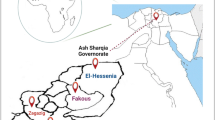Abstract
Norovirus (NoV) is a major cause of acute non-bacterial gastroenteritis in all age groups worldwide. To detect NoV from foods, polyethylene glycol (PEG) precipitation or ultracentrifugation methods are generally used with reverse transcription (RT)-PCR. These methods need to use complicated procedures and varied buffers depending on the kinds of food matrices. In this study, we suggested a universal method to recover NoV in food and water samples as a prior step to real-time RT-PCR. As a NoV surrogate model, feline calicivirus (FCV) was used. FCV was artificially inoculated to samples, and then concentrated by the adsorption-elution method using negatively charged membrane filters. The detection limit was 4.3×101 PFU/250 mL for distilled water, 4.3×102 PFU/250 mL for environmental waters, and 4.3×102 PFU/15 g for lettuce and oyster. We were able to identify the possibility of one universal and time-saving method to detect NoV in food and water samples without modifications.
Similar content being viewed by others
References
Cliver DO. Virus transmission via food. World Health Stat. Q. 50: 90–101 (1997)
Koopmans M, Bonsdorff CH, Vinje J, Medici D, Monroe S. Foodborne viruses. FEMS Microbiol. Rev. 26: 187–205 (2002)
Scipioni A, Bourgot I, Mauroy A, Ziant D, Saegerman C, Daube G, Thiry E. Detection and quantification of human and bovine noroviruses by a TaqMan RT-PCR assay with a control for inhibition. Mol. Cell. Probe. 22: 215–222 (2008)
Bresee JS, Widdowson MA, Monroe SS, Glass RI. Foodborne viral gastroenteritis: Challenges and opportunities. Clin. Infect. Dis. 35: 748–753 (2002)
Di Pasquale S, Paniconi M, Auricchio B, Orefice L, Schultz AC, De Medici D. Comparison of different concentration methods for the detection of hepatitis A virus and calicivirus from bottled natural mineral waters. J. Virol. Methods 165: 57–63 (2010)
Seymour IJ, Appleton H. Foodborne viruses and fresh produce. J. Appl. Microbiol. 91: 759–773 (2001)
Korea Food & Drug Administration. Present conditions of foodborne viruses. Available from: http://fm.kfda.go.kr/ Accessed August 04, 2010.
Fleet GH, Heiskanen P, Reid I, Buckle KA. Foodborne viral illness — Status in australia. Int. J. Food Microbiol. 59: 127–136 (2000)
Svensson L. Diagnosis of foodborne viral infections in patients. Int. J. Food Microbiol. 59: 117–126 (2000)
Cliver DO. Detection and control of foodborne viruses. Trends Food Sci. Tech. 6: 353–358 (1995)
Koopmans M, Durzer E. Foodborne viruses: An emerging problem. Int. J. Food Microbiol. 90: 23–41 (2004)
Green KY, Ando T, Balayan MS, Berke T, Clarke IN, Estes MK, Matson KO, Nakata S, Neill JD, Studdert MJ, Thiel HJ. Taxonomy of the caliciviruses. J. Infect. Dis. 181: S322–S330 (2000)
Clarke IN, Lambden PR. Organization and expression of calicivirus genes. J. Infect. Dis. 181: S309–S316 (2000)
Radford AD, Coyne KP, Dawson S, Porter CJ, Gaskell RM. Feline calicivirus. Vet. Res. 38: 319–335 (2007)
Doultree JC, Druce JD, Birch CJ, Bowden DS, Marshall JA. Inactivation of feline calicivirus, a norwalk virus surrogate. J. Hosp. Infect. 41: 51–57 (1999)
Tree JA, Adams MR, Lees DN. Disinfection of feline calicivirus (a surrogate for norovirus) in wastewaters. J. Appl. Microbiol. 98: 155–162 (2005)
Gehrkea C, Steinmanna J, Goroncy-Bermes P. Inactivation of feline calicivirus, a surrogate of norovirus (formerly norwalk-like viruses), by different types of alcohol in vitro and in vivo. J. Hosp. Infect. 56: 49–55 (2004)
Baert L, Uyttendaele M, Debevere J. Evaluation of viral extraction methods on a broad range of ready-to-eat foods with conventional and real-time RT-PCR for norovirus GII detection. Int. J. Food Microbiol. 123: 101–108 (2008)
Guevremont E, Brassard J, Houde A, Simard C, Trottier YL. Development of an extraction and concentration procedure and comparison of RT-PCR primer systems for the detection of hepatitis A virus and norovirus GII in green onions. J. Virol. Methods 134: 130–135 (2006)
Schultz AC, Saadbye P, Hoorfar J, Norrung B. Comparison of methods for detection of norovirus in oysters. Int. J. Food Microbiol. 114: 352–356 (2007)
Katayama H, Shimasaki A, Ohgaki S. Development of a virus concentration method and its application to detection of enterovirus and norwalk virus from coastal seawater. Appl. Environ. Microb. 68: 1033–1039 (2002)
Bidawid S, Malik N, Adegbunrin O, Sattar SA, Farber JM. A feline kidney cell line-based plaque assay for feline calicivirus, a surrogate for norwalk virus. J. Virol. Methods 107: 163–167 (2003)
Abd-Eldaim MM, Wilkes RP, Thomas KV, Kennedy MA. Development and validation of a TaqMan real-time reverse transcription-PCR for rapid detection of feline calicivirus. Arch. Virol. 154: 555–560 (2009)
Haramoto E, Katayama H, Utagawa E, Ohgaki S. Recovery of human norovirus from water by virus concentration methods. J. Virol. Methods 160: 206–209 (2009)
Leggitt PR, Jaykus LA. Detection methods for human enteric viruses in representative foods. J. Food Protect. 63: 1738–1744 (2000)
Loisy F, Atmar RL, Guillon P, Le Cann P, Pommepuy M, Le Guyader FS. Real-time RT-PCR for norovirus screening in shellfish. J. Virol. Methods 123: 1–7
Author information
Authors and Affiliations
Corresponding author
Rights and permissions
About this article
Cite this article
Cho, MG., Jeong, HM., Ahn, JB. et al. Detection of feline calicivirus as norovirus surrogate in food and water sources using filtration and real-time RT-PCR. Food Sci Biotechnol 20, 1475–1480 (2011). https://doi.org/10.1007/s10068-011-0204-5
Received:
Revised:
Accepted:
Published:
Issue Date:
DOI: https://doi.org/10.1007/s10068-011-0204-5




